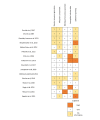The Effectiveness of Virtual Reality Exposure-Based Cognitive Behavioral Therapy for Severe Anxiety Disorders, Obsessive-Compulsive Disorder, and Posttraumatic Stress Disorder: Meta-analysis
- PMID: 35142632
- PMCID: PMC8874794
- DOI: 10.2196/26736
The Effectiveness of Virtual Reality Exposure-Based Cognitive Behavioral Therapy for Severe Anxiety Disorders, Obsessive-Compulsive Disorder, and Posttraumatic Stress Disorder: Meta-analysis
Abstract
Background: In recent years, virtual reality exposure-based cognitive behavioral therapy (VRE-CBT) has shown good treatment results in (subclinical) anxiety disorders and seems to be a good alternative to exposure in vivo in regular cognitive behavioral therapy (CBT). However, previous meta-analyses on the efficacy of VRE-CBT on anxiety disorders have included studies on specific phobias and subthreshold anxiety; therefore, these results may not be generalizable to patients with more severe and disabling anxiety disorders.
Objective: The objective of our study is to determine the efficacy of VRE-CBT on more severe anxiety disorders, excluding specific phobias and subthreshold anxiety disorders. Meta-analyses will be conducted to examine the efficacy of VRE-CBT versus waitlist and regular CBT. Our secondary objectives are to examine whether the efficacy differs according to the type of anxiety disorder, type of recruitment, and type of VRE-CBT (virtual reality exposure either with or without regular CBT). Furthermore, attrition in VRE-CBT and CBT will be compared.
Methods: Studies published until August 20, 2020, were retrieved through systematic literature searches in PubMed, PsycINFO, and Embase. We calculated the effect sizes (Hedges g) for the difference between the conditions and their 95% CIs for posttest and follow-up measurements in a random effects model. A separate meta-analysis was performed to compare attrition between the VRE-CBT and CBT conditions.
Results: A total of 16 trials with 817 participants were included. We identified 10 comparisons between VRE-CBT and a waitlist condition and 13 comparisons between VRE-CBT and a CBT condition. With regard to risk of bias, information on random sequence generation, allocation concealment, and risk of bias for selective outcome reporting was often absent or unclear. The mean effect size of VRE-CBT compared with waitlist (nco=10) was medium and significant, favoring VRE-CBT (Hedges g=-0.490, 95% CI -0.82 to -0.16; P=.003). The mean effect size of VRE-CBT compared with CBT (nco=13) was small and nonsignificant, favoring CBT (Hedges g=0.083, 95% CI -0.13 to 0.30; P=.45). The dropout rates between VRE-CBT and CBT (nco=10) showed no significant difference (odds ratio 0.79, 95% CI 0.49-1.27; P=.32). There were no indications of small study effects or publication bias.
Conclusions: The results of our study show that VRE-CBT is more effective than waitlist and as effective as CBT in the treatment of more severe anxiety disorders. Therefore, VRE-CBT may be considered a promising alternative to CBT for patients with more severe anxiety disorders. Higher-quality randomized controlled trials are needed to verify the robustness of these findings.
Keywords: anxiety disorders; cognitive behavioral therapy; meta-analysis; mobile phone; virtual reality; virtual reality exposure therapy.
©Inge van Loenen, Willemijn Scholten, Anna Muntingh, Johannes Smit, Neeltje Batelaan. Originally published in the Journal of Medical Internet Research (https://www.jmir.org), 10.02.2022.
Conflict of interest statement
Conflicts of Interest: None declared.
Figures






References
-
- Carpenter JK, Andrews LA, Witcraft SM, Powers MB, Smits JAJ, Hofmann SG. Cognitive behavioral therapy for anxiety and related disorders: a meta-analysis of randomized placebo-controlled trials. Depress Anxiety. 2018;35(6):502–14. doi: 10.1002/da.22728. http://europepmc.org/abstract/MED/29451967 - DOI - PMC - PubMed
Publication types
MeSH terms
LinkOut - more resources
Full Text Sources
Medical

